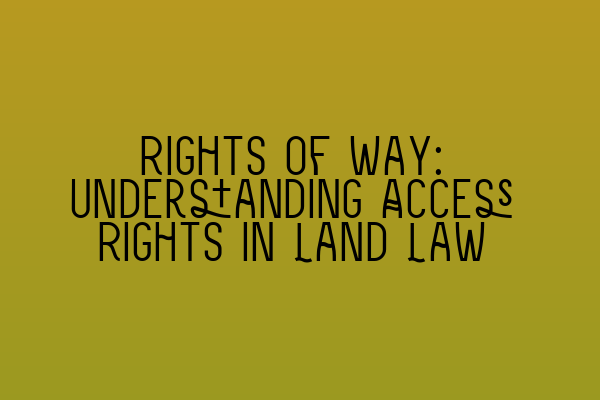Rights of Way: Understanding Access Rights in Land Law
Welcome to SQE Property Law & Land Law’s blog post on understanding access rights in land law. In this article, we will explore the concept of rights of way and provide you with a comprehensive understanding of how these access rights work.
Before diving into the details, let’s first define what a right of way is. In land law, a right of way is a legal right that allows a person to traverse or use someone else’s land for specific purposes, such as accessing their own property or reaching a public place.
Types of Rights of Way
There are two main types of rights of way: public rights of way and private rights of way. Public rights of way are usually established by law and grant the general public access to certain areas. These can include footpaths, bridleways, and even roads. On the other hand, private rights of way are created by agreement between parties and are limited to specific individuals or properties.
Now let’s delve deeper into each type of right of way.
Public Rights of Way
Public rights of way are crucial for ensuring public access to various areas for recreational purposes. These rights are typically created by operations of law, dedicated footpaths, or official designations. Common examples include:
- Public footpaths: These rights of way are designated for pedestrians and are usually indicated by signage or marked paths.
- Bridleways: These rights of way allow walkers, horse riders, and cyclists to access specific areas.
- Byways open to all traffic: These rights of way permit various types of vehicles, including motor vehicles, to use designated routes.
Public rights of way are protected by legislation and should not be obstructed by landowners. However, it’s important to note that landowners may impose reasonable restrictions to protect their property, as long as these restrictions do not unduly interfere with the public’s right of access.
Private Rights of Way
Unlike public rights of way, private rights of way are established through private agreements between landowners. These agreements can be in the form of express grants or implied rights. Common examples of private rights of way include:
- Access to neighboring properties: This type of right of way allows property owners to access their land via their neighbor’s property.
- Access to shared amenities: In some cases, properties may have rights of way to access shared amenities such as parks, lakes, or recreational facilities.
- Access to public roads: Some properties may have private rights of way over adjacent properties to reach public roads.
Private rights of way are subject to the terms agreed upon by the parties involved. It’s important for both landowners and individuals with rights of way to understand and respect the rights and obligations specified in these agreements.
Resolving Disputes
Despite the existence of clear rights of way, disputes can arise between parties. Whether it’s a landowner restricting access to a public right of way or disagreement over the terms of a private right of way, it’s essential to handle conflicts in a legally compliant and fair manner.
If you find yourself involved in a dispute regarding rights of way, it’s advisable to seek legal advice from qualified property law professionals. They can guide you through the legal process and help you protect your rights or resolve the dispute amicably.
At SQE Property Law & Land Law, we are dedicated to providing expert legal advice and assistance in property law matters, including rights of way disputes. Our experienced solicitors can help you navigate through complex legal issues and strive to achieve a favorable resolution.
For more information on our services or to get in touch with our team, please visit our website: https://fqps.co.uk.
Related Articles:
